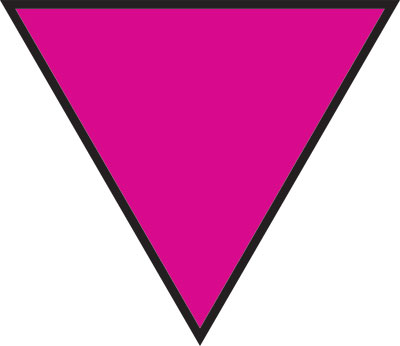  Triangle History |
| The Rainbow Triangle is easily one of the more popular symbols for the gay community. |
| During WWII, gays were only one of the many groups targeted for extermination by the Nazi regime. It is unfortunately the group that history often excludes. |
| The history of the triangle begins before WWII, during Adolph Hitler's rise to power. Paragraph 175, a clause in German law prohibiting gay relations, was revised by Hitler in 1935 to include kissing, embracing, and gay fantasies as well as sexual acts. Convicted offenders -- an estimated 25,000 just from 1937 to 1939 -- were sent to prison and then later to concentration camps. Their sentence was to be sterilized, and this was most often accomplished by castration. In 1942 Hitler's punishment for homosexuality was extended to death. |
| The social Hierarchy among prisoners. |
| (1.) The green triangle marked its wearer as a regular
criminal (2.) The red triangle denoted a political prisoner (3.) Two yellow triangles overlapping to form a Star of David designated a Jewish prisoner (4.) The pink triangle was for gay men (5.) The black triangle was for lesbians, prostitutes; women who refused to bear children (6.) A yellow Star of David under a superimposed pink triangle marked the lowest of all prisoners -- a gay Jew. |
| Although the total number of the gay prisoners is not known.
Gay prisoners reportedly were not shipped en masse to the death camps at
Auschwitz, a great number of gay men were among the non-Jews who were killed
there. Estimates of the number of gay men killed during the Nazi regime
range from 50,000 to twice that figure. When the war was finally over, countless homosexuals remained prisoners in the camps, because Paragraph 175 remained law in West Germany until its repeal in 1969. |
| In the 1970's, gay liberation groups resurrected the pink triangle as a popular symbol for the gay rights movement in the 1980’s; ACT-UP (AIDS Coalition To Unleash Power) began using the pink triangle for their cause. They inverted the symbol, making it point up, to signify an active fight back rather than a passive resignation to fate. Black Triangle |
| Like the pink triangle, the black triangle is also rooted in Nazi Germany. Although lesbians were not included in the Paragraph 175 prohibition of homosexuality, there is evidence to indicate that the black triangle was used to designate prisoners with anti-social behavior. Considering that the Nazi idea of womanhood focused on children, kitchen, and church, black triangle prisoners may have included lesbians, prostitutes; women who refused to bear children, and women with other "anti-social" traits. As the pink triangle is historically a male symbol, lesbians and feminists have similarly reclaimed the black triangle as a symbol of pride and solidarity. |